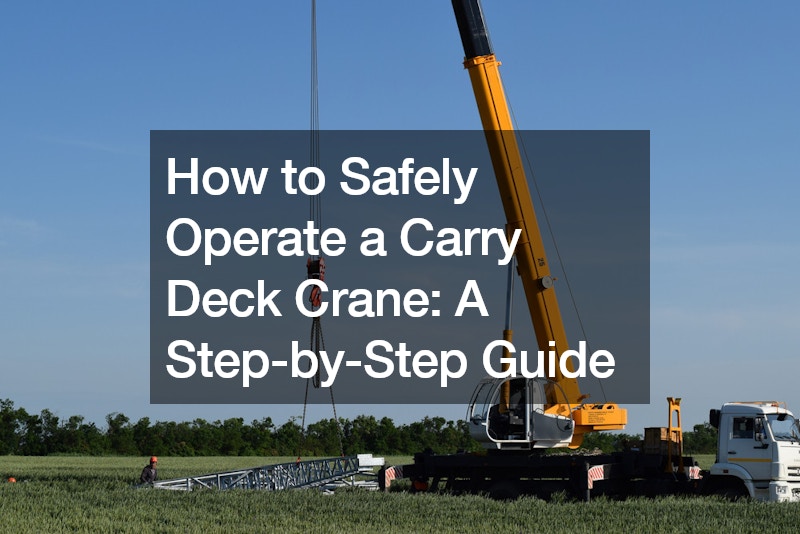How to Safely Operate a Carry Deck Crane A Step-by-Step Guide

A carry deck crane is a specialized type of crane designed for versatility and maneuverability, making it an indispensable asset in various construction and industrial settings. Unlike larger cranes, which often require ample space for operation, carry deck cranes are compact and agile, allowing them to navigate through tight spaces and confined job sites with ease.
At the heart of a carry deck crane is its unique design, featuring a revolving boom that rotates a full 360 degrees at the machine’s center. This innovative configuration enables the crane to reach and lift loads from virtually any angle, providing unparalleled flexibility in material handling tasks.
Additionally, the operator cab situated beneath the boom offers excellent visibility, allowing operators to have a clear view of their surroundings while maneuvering the crane.
One of the key advantages of a carry deck crane is its ability to lift heavy loads in areas where space is limited. The level platform above the wheels provides a stable base for loading and transporting materials across the job site. Despite its compact size, a carry deck crane boasts impressive lifting capacities, with some models capable of hoisting loads up to 15 tons. This makes them ideal for a wide range of lifting and moving applications, from loading and unloading materials to positioning equipment and machinery.
Moreover, carry deck cranes are renowned for their smooth and precise operations, thanks to fully hydraulic controls that offer exceptional control and responsiveness. This allows operators to execute lifting tasks with precision and efficiency, minimizing the risk of accidents or damage to the surrounding environment. Whether lifting heavy equipment or delicate materials, operators can rely on the precise control offered by carry deck cranes to safely and efficiently complete their tasks.
In addition to their lifting capabilities, carry deck cranes excel in navigating confined spaces and traversing obstacles commonly encountered on job sites. Their compact footprint and agile maneuverability make them indispensable for tasks that require precision and flexibility, such as working in congested construction sites or indoor environments where overhead obstructions are present.
Safety is paramount when operating a carry deck crane, and operators must undergo proper training and certification to ensure safe and responsible use of the equipment. Certification programs, such as those offered by organizations like the National Commission for the Certification of Crane Operators (NCCCO), provide comprehensive training on crane operation, safety protocols, and industry best practices.Operating heavy machinery like a carry deck crane requires skill, precision, and a thorough understanding of safety protocols. Whether you’re a seasoned operator or new to the job, it’s crucial to prioritize safety above all else. In this comprehensive guide, we’ll walk you through the step-by-step process of safely operating a carry deck crane, highlighting its key features, applications, and safety measures.
Understanding the Carry Deck Crane
A carry deck crane is a compact four-wheel crane equipped with a revolving boom that can rotate 360 degrees. Its unique design includes an operator cab positioned underneath the boom at one end, with the engine located at the rear half of the crane. The level platform above the wheels makes it ideal for loading and transporting materials around construction sites.
Versatility and Maneuverability
One of the primary advantages of a carry deck crane is its versatility and maneuverability. Despite its small size, it packs a considerable amount of power, making it suitable for various job site tasks. Its ability to traverse confined spaces while clearing overhead obstructions makes it an invaluable asset on construction sites.
Applications of Carry Deck Cranes
Carry deck cranes are incredibly adaptable and can perform a wide range of duties on job sites. They excel at lifting items that require small, low-profile cranes, such as transferring goods throughout the site. With weight capacities of up to 15 tons and the ability to pick up and carry loads of over 9 tons on certain models, carry deck cranes are indispensable for handling heavy materials.
Operating Procedures
Before operating a carry deck crane, it’s essential to undergo proper training and certification to comply with safety regulations. Operators must be well-versed in the crane’s controls and functions, ensuring smooth and precise operations. Fully hydraulic controls are standard on carry deck cranes, allowing operators to maneuver with ease and accuracy.
Safety Measures
Safety should always be the top priority when operating a carry deck crane. Operators must follow strict safety guidelines to prevent accidents and injuries. Here are some crucial safety measures to keep in mind:
Certification: Operators must be certified to operate a carry deck crane, as mandated by OSHA regulations. Certification can be obtained through accredited testing bodies or employer-sponsored programs.
Inspection: Before each use, conduct a thorough inspection of the crane to ensure it is in proper working condition. Check for any signs of damage or wear and tear that could compromise safety.
Load Capacity: Never exceed the crane’s specified load capacity. Overloading can lead to instability and pose a significant safety risk.
Stability: Maintain proper stability by ensuring the crane is set up on a firm, level surface. Use outriggers or stabilizers as needed to prevent tipping.
Clearance: Be aware of overhead obstructions and maintain a safe distance from power lines, buildings, and other structures.
Communication: Establish clear communication with ground personnel and other workers on the job site to coordinate movements and ensure everyone’s safety.
Emergency Procedures: Familiarize yourself with emergency procedures in case of accidents or equipment malfunctions. Know how to shut off the crane and evacuate safely if necessary.
Conclusion
Operating a carry deck crane requires skill, training, and a commitment to safety. By following the step-by-step guide outlined above and adhering to strict safety measures, operators can ensure the safe and efficient use of this versatile piece of equipment. Remember, safety is everyone’s responsibility, and prioritizing it is essential to preventing accidents and injuries on the job site.
.

